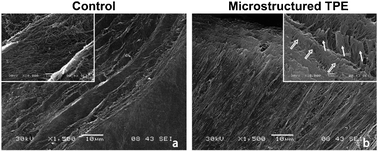Surface topography induces 3D self-orientation of cells and extracellular matrix resulting in improved tissue function†
Abstract
The organization of cells and

* Corresponding authors
a LOEX, Centre de recherche (FRSQ) du CHA de Québec, Quebec City, PQ, Canada
b
Department of Surgery, Faculty of Medicine, Laval University, Quebec City, PQ, Canada
E-mail:
francois.auger@chg.ulaval.ca
c Industrial Materials Institute, National Research Council, Boucherville, PQ, Canada
d School of Optometry, Research Unit in Ophthalmology, Montreal University, Montreal, PQ, Canada
e Biomedical Engineering Department, Cornell University, Ithaca, USA
f Center for Engineering in Medicine and Surgical Services, Massachusetts General Hospital, Harvard Medical School, and Shriners Hospital for Children, Boston, USA
The organization of cells and

 Please wait while we load your content...
Something went wrong. Try again?
Please wait while we load your content...
Something went wrong. Try again?
 Fetching data from CrossRef.
Fetching data from CrossRef.
This may take some time to load.
Loading related content
